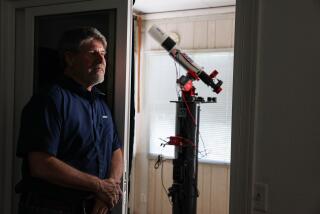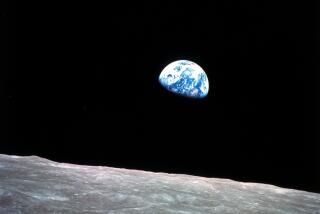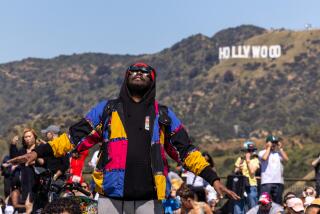Photographer Clicks With Shooting Stars
- Share via
John Sanford began his career as an Army photographer in Vietnam during the war, capturing some of humanity’s most disturbing moments on film.
But he made his mark as a professional photographer by aiming his lens toward the heavens, creating inspiring images of the cosmos that have been published in books and magazines throughout the world.
The 58-year-old Costa Mesa resident has managed to combine his skill in photography and his passion for astronomy into a single career. A professor of photography, Sanford is nearing his 30th year at Orange Coast College. But he claims a half-century of stargazing, dating back to his first observation of a solar eclipse at age 8.
“My dad was a machinist, and he helped me put together a little kit that consisted of a 2-inch lens. He put it in a tube and made the focusing device for me. We looked at Jupiter with it. I got my first serious telescope on my 12th birthday. It had a 3-inch refractor.”
As president of the 625-member Orange County Astronomers, considered the largest locally based amateur astronomy club in the United States, Sanford now explores outer space with a 22-inch telescope, among others.
Construction of the telescope was completed in 1984 by club member William Kuhn in his Lemon Heights garage. It was installed at the club’s 20-acre observatory in Riverside County, a prime viewing site 12 miles northeast of Palomar Observatory. The 30-year-old club also has a one-acre viewing site in Silverado Canyon where members have monthly “star parties.”
Sanford and club members travel throughout the world to witness astronomical events. They are planning a trip to the northwest tip of Venezuela in February to watch a total eclipse of the sun. It is an event worth the trip, Sanford said.
“A total solar eclipse is probably one of nature’s most awe-inspiring events. Daylight turns into night in just a couple seconds. You see the stars come out, the birds roost, and all kinds of interesting nocturnal things happen. It cools off usually about seven to 10 degrees. Solar eclipses can go as long as about seven minutes and as short as a few seconds.
“It’s a very impressive and a very emotional thing. You know it’s coming exactly to the second. You’re out there, and everybody starts counting down, and afterward everybody claps and swoons and has all kinds of emotional reactions. You get kind of addicted to it.”
While Sanford scans the heavens through his assorted telescopes, he’s also adding to the library of photographs he sells to publishers through Astrostock, a business he began in 1984. Photographing the heavens has changed significantly during the last five years with the advent of affordable electronic-imaging cameras.
The cameras digitize light using computer chips called charge-coupled devices (CCDs). The CCD cameras are 40 times more sensitive to light than conventional equipment and can detect stars that are 100,000 times as faint as the night sky. Sanford wrote a chapter on the subject in the book, “The Art and Science of CCD Astronomy,” published earlier this year.
“The electronic camera has certainly revolutionized astronomy. It’s allowed astronomers to multiply the size of the telescope by a factor of from four to six times, in terms of what you can get and how quickly you can get it.”
Sanford had once considered becoming an astronomer but found the required mathematics too rigorous. He is one of about 300,000 amateur astronomers in the United States whose often exhaustive labors supplement the work of professionals.
“About half of the fairly bright supernovas are discovered by amateurs. During that first period when a supernova is first going off, a lot of the elements are being created. That’s when the astronomers want to look at the supernovas, just as they’re happening.”
Orange County Astronomers member Wayne Johnson, an electrical engineer, has discovered five supernovas at the club’s Riverside County observatory, Sanford said.
“The guys who discover supernovas often have photographic memories. They have a bunch of galaxies they’ve looked at over and over again. They can look at a hundred galaxies an hour, for two or three hours, and recognize if there’s anything new. Then they go to the chart and check, to make sure.”
As Sanford nears retirement from his teaching career, he plans on spending a lot more time searching the heavens.
“There’s always a chance for an amateur to discover something. I’m going to start looking for comets. You usually have to put hundreds of hours in before you find one. You have to live in a dark place. I’m thinking of moving to rural Hawaii. I can’t do it here because of light pollution.
“And if you discover a comet, you wouldn’t want to stop. Otherwise, you might think it was some kind of fluke or something. You’ve got to at least get a second one. I think it’s quite feasible to find one, if you look long enough.”
(BEGIN TEXT OF INFOBOX / INFOGRAPHIC)
Profile: John Sanford
Age: 58
Hometown: Newburgh, N.Y.
Residence: Costa Mesa
Family: Two grown children
Education: Bachelor’s degree in sociology and anthropology, Cornell University; master’s degree in creative arts with an emphasis on photography, San Francisco State University
Background: Photographed in Vietnam for the Army 1962-63; photographic technician for IBM, 1964-66; photographed Delta rocket tests for Lockheed Aerospace, 1966-68; professor of photography at Orange Coast College since 1969
Stargazing: Observed first solar eclipse at age 8; founded Newburgh Astronomy Club at his junior high school at age 12; won gold medal in astrophotography at age 16 at the New York state science fair; joined Orange County Astronomers in 1970 and serves as president and newsletter editor; winner of the Bruce Blair Award presented by Western Amateur Astronomers in 1983 for contributions to amateur astronomy; founded Astrostock in 1984, a business providing astrophotography for books and publications; author of “Observing the Constellations,” (Simon & Schuster, 1989, translated into five languages); the “Sanford” asteroid, discovered by Eleanor Helin at Palomar Observatory in 1989, was named in his honor; author of a chapter in “The Art and Science of CCD Astronomy” (Springer-Verlag, 1997)
On excitement of a solar eclipse: “You’re out there, and everybody starts counting down, and afterward everybody claps and swoons and has all kinds of emotional reactions. You get kind of addicted to it.”
Source: John Sanford; Researched by RUSS LOAR / For The Times
More to Read
Sign up for The Wild
We’ll help you find the best places to hike, bike and run, as well as the perfect silent spots for meditation and yoga.
You may occasionally receive promotional content from the Los Angeles Times.






